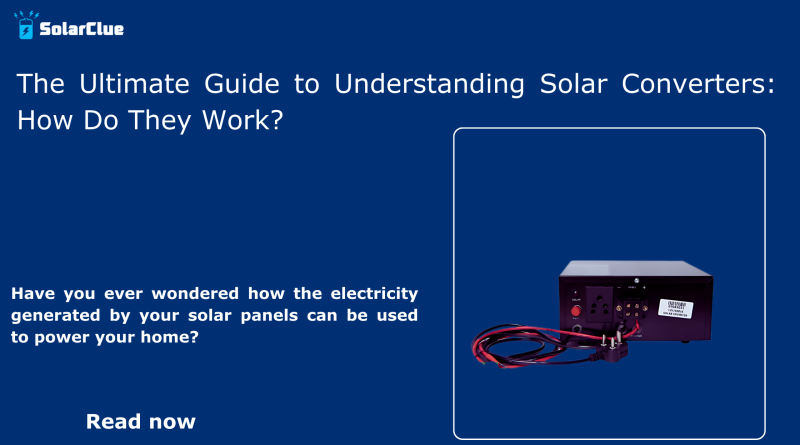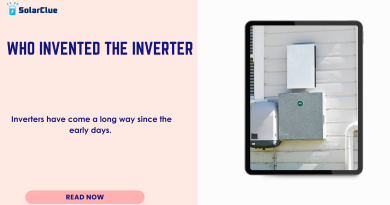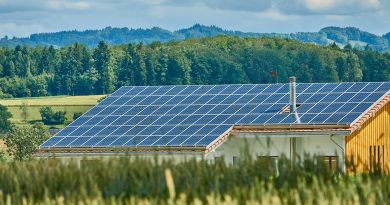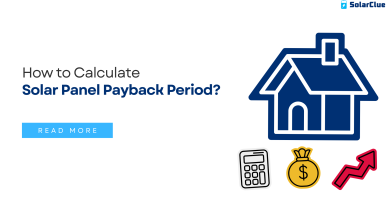The Ultimate Guide to Understanding Solar Converters
Hello there! Have you ever wondered how the electricity generated by your solar panels can be used to power your home? The secret lies in a critical component called a solar converter. In this guide, we’ll explore everything you need to know about solar converters, how they work, and why they are essential in a solar power system. We’ll keep it simple and straightforward, so you can easily understand how this vital piece of equipment helps you harness the power of the sun. Let’s dive in and simplify solar converters together!
Table of Contents
What is a Solar Converter?
A solar converter, also known as a solar inverter, is a device that converts the direct current (DC) electricity produced by solar panels into alternating current (AC) electricity. AC is the type of power that most household appliances and the electrical grid use. Without a solar converter, the electricity generated by your solar panels wouldn’t be usable for your home or be able to feed into the grid.
Why is a Solar Converter Important?
1.Compatibility with Home Appliances
Most household appliances and devices run on AC power. The solar converter ensures that the DC power from your solar panels is converted to AC power, making it compatible with your home’s electrical system.
2.Grid Connection
If your home is connected to the electrical grid, the solar converter is essential for synchronizing the solar power with the grid’s AC power. This allows you to feed excess electricity back into the grid and benefit from net metering or similar programs.
3.Safety and Efficiency
Solar converters ensure that the electricity generated by your solar panels is safe to use and efficiently converted. This maximizes the energy output from your solar panels, allowing you to make the most of your investment.
Types of Solar Converters
There are several types of solar converters, each with its own set of advantages and disadvantages. Understanding these can help you choose the best one for your needs.
1.String Inverters
String inverters are the most common type of solar converter. They connect a series of solar panels (a “string”) to a single inverter.
– Advantages: Cost-effective, reliable, and straightforward to install.
– Disadvantages: If one panel underperforms (due to shading or dirt), the performance of the entire string is affected.
2.Microinverters
Microinverters are installed on each solar panel, converting DC to AC at the panel level.
– Advantages: Improved efficiency, better performance in shaded conditions, and easy to expand the system.
– Disadvantages: More expensive upfront compared to string inverters.
3.Power Optimizers
Power optimizers are similar to microinverters but are paired with a central string inverter. They condition the DC power from each panel before sending it to the inverter.
– Advantages: Improved system performance, especially in partial shading, and more affordable than microinverters.
– Disadvantages: Slightly more complex installation and higher cost compared to string inverters alone.
4.Hybrid Inverters
Hybrid inverters can manage inputs from both solar panels and battery storage systems.
– Advantages: Ideal for systems with battery storage, simplifies installation, and can manage multiple power sources.
– Disadvantages: More expensive and complex than standard string inverters.
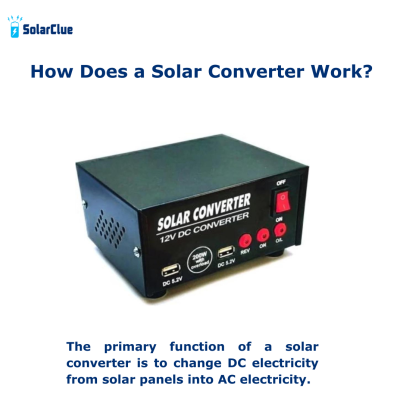
How Does a Solar Converter Work?
The primary function of a solar converter is to change DC electricity from solar panels into AC electricity. Here’s a step-by-step explanation of how it works:
1.DC Power Generation: Solar panels capture sunlight and convert it into DC electricity.
2.DC Input to Converter: The DC electricity flows from the panels to the solar converter.
3.Conversion Process: The solar converter uses electronic components (like transistors and transformers) to switch and shape the DC power into AC power.
4.AC Output: The converted AC electricity is then sent to your home’s electrical system, ready to power your appliances.
Step-by-Step Process
1.DC Generation by Solar Panels: Solar panels consist of photovoltaic (PV) cells that capture sunlight and convert it into DC electricity. This electricity is then sent to the solar converter.
2.Input to the Solar Converter: The DC electricity enters the solar converter through input terminals. The converter is equipped with various electronic components, including switches and transformers, that help in the conversion process.
3.DC to AC Conversion: The converter’s main job is to turn the DC electricity into AC electricity. It does this by using an inverter circuit, which rapidly switches the DC input on and off. This switching creates a wave of electricity that the converter then shapes into a smooth AC waveform.
4.Filtering and Regulation: The AC electricity produced by the initial conversion process may contain some ripples or noise. The solar converter filters out these imperfections to produce clean, stable AC power.
5.AC Output: The final AC electricity is then sent to your home’s electrical system, where it can be used to power your appliances, lights, and other devices.
6.Grid Synchronization (if applicable): If your home is connected to the grid, the solar converter also ensures that the AC power it produces is in sync with the grid’s power. This is crucial for safety and to allow any excess electricity to be fed back into the grid.
Features to Consider When Choosing a Solar Converter
When selecting a solar converter, consider the following features to ensure you get the best performance and value for your system:
1.Efficiency
Higher efficiency means more of the DC power is converted to usable AC power. Look for inverters with efficiency ratings of 95% or higher.
2.Warranty and Lifespan
A good solar converter should come with a warranty of at least 5-10 years. Some manufacturers offer extended warranties up to 25 years. Check the expected lifespan to ensure long-term reliability.
3.Compatibility
Ensure the solar converter is compatible with your solar panel system, including voltage and power output specifications. If you plan to add batteries in the future, consider a hybrid inverter.
4.Monitoring Capabilities
Many modern inverters come with monitoring features that allow you to track the performance of your solar system in real-time via a smartphone app or web portal.
5.Safety Features
Look for inverters with safety features like overvoltage protection, short-circuit protection, and anti-islanding protection (which ensures the inverter shuts down during a grid outage to protect utility workers).
Installation and Maintenance
Installation
Proper installation is crucial for the safe and efficient operation of your solar converter. Here are some key points:
– Professional Installation: It’s recommended to have a certified installer handle the installation to ensure compliance with local codes and safety standards.
– Location: Install the inverter in a cool, dry, and well-ventilated area to prevent overheating and ensure optimal performance.
– Wiring: Proper wiring and connections are essential to avoid energy losses and ensure the safety of the system.
Maintenance
While solar converters are generally low-maintenance, regular checks and basic maintenance can prolong their lifespan and ensure they operate efficiently.
– Visual Inspections: Periodically check for any visible signs of wear, damage, or overheating.
– Cleaning: Keep the inverter and surrounding area clean to prevent dust and debris buildup.
– Firmware Updates: Some inverters may require firmware updates to improve performance and add new features. Check with the manufacturer for updates.
Common Issues and Troubleshooting
Even with the best equipment and installation, issues can occasionally arise. Here are some common problems and how to troubleshoot them:
1.No Power Output
– Check Connections: Ensure all cables and connections are secure.
– System Status: Check the inverter’s display or monitoring app for error codes or warnings.
– Circuit Breakers: Verify that all circuit breakers are in the correct position.
2.Low Power Output
– Shading: Check if any new shading has appeared on your solar panels.
– Panel Cleanliness: Clean your panels to ensure they’re capturing maximum sunlight.
– System Health: Use the monitoring app to check the performance of individual panels and the overall system.
3.Inverter Overheating
– Ventilation: Ensure the inverter is in a well-ventilated area and not blocked by any objects.
– Ambient Temperature: Check the ambient temperature around the inverter. High temperatures can affect performance.
– Cooling Fans: If the inverter has cooling fans, ensure they’re functioning correctly.
Conclusion
And there you have it – the ultimate guide to understanding solar converters! These devices are the heart of your solar power system, making it possible to use the clean, renewable energy generated by your solar panels to power your home. By choosing the right solar converter and ensuring proper installation and maintenance, you can maximize the benefits of your solar investment. Whether you’re looking to save on energy bills, reduce your carbon footprint, or gain energy independence, a reliable solar converter is essential.
Visit SolarClue® to see the best Solar Inverters. SolarClue® actively sells solar energy products at discounts of up to 50% on its online marketplace.

